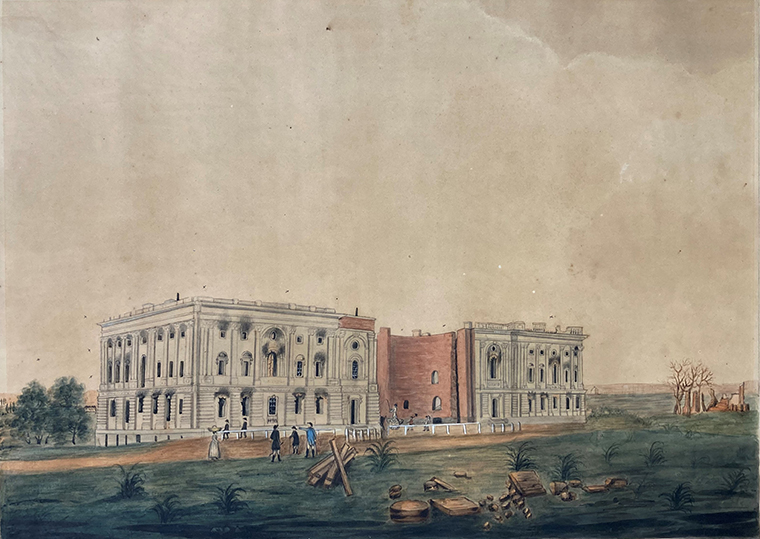AN UNPRECEDENTED EVENT
Wednesday, January 6, 2021 was to be a day of routine business for the U.S. Congress in session at the Capitol. On the docket: certifying the results of the 2020 presidential election. In other eras, this vote was pro forma, a way for Congress to affirm the results from each state.
Instead the day became one of shock and insurrection.
Embedded in the DC History Center’s mission is the responsibility to provide historical context for the events of our day and thereby promote understanding of who we are as a community. The assault on the U.S. Capitol, incited by a sitting president intent on upending the results of a fair and lawful election, is unprecedented. But there have been attacks on U.S. sovereignty on our soil before, attacks both domestic and foreign.

So in the spirit of providing connections with the past, this edition of Context for Today offers resources on the British burning of the Capitol in 1814, during the War of 1812; the assassination of President Abraham Lincoln; the bombing of the building in 1954 by Puerto Rican nationalists demanding independence, and other incursions into the Capitol and challenges to the American government.
Readers interested in learning more about the history of the quest for DC Statehood, the lack of which has serious implications for the city’s ability to protect itself and the federal presence, may learn more on our Context for Today page on statehood.
Recommended Reading
COMPILATIONS
Resources for teaching the January 6th Insurrection, compiled by DC Public Schools Social Studies teachers, 2021.
Politifact, the fact-checking website of the Poynter Institute, collected statements about the assault on the Capitol from the Internet and checked their veracity. It also describes seven other events when the Capitol and its legislators have come under violent attack.
American Insurrection: The U.S. Capitol’s turbulent history of bombings, assassination attempts, and violence, by Amy McKeever and David Beard, National Geographic, 2021.
Political extremists have attacked the U.S. Capitol before: A history of the violence, by Gillian Brockell, Washington Post, 2021.
BURNING OF THE CAPITOL
The Burning of Washington: The British Invasion of 1814 by Anthony Pitch (U.S. Naval Institute Press, 1988). A step-by-step account of the British invasion during the War of 1812, the last time the U.S. Capitol was breached.
Diary of Michael Shiner Relating to the History of the Washington Navy Yard 1813-1869, transcribed with Introduction and Notes by John G. Sharp (2007 and 2015)
Thank You, General Ross: How Washington Won the Battle to Keep the Federal Government in 1814, by Kenneth R. Bowling, Washington History 29-2 (2017). The author of The Creation of Washington, D.C. argues that the nation’s capital might not have remained here had it not been for the patriotism evoked by the burning of Washington.
” ‘Queen Dolley’ Saves Washington City,’ “ by Catherine Allgor, Washington History 12-1 (2000). An account by the author of Parlor Politics of the role of First Lady Dolley Madison in assuring that the nation’s capital would remain in Washington after the disastrous burning of the federal buildings by the British during the War of 1812.
PUERTO RICAN NATIONALISTS’ ASSAULTS
“Puerto Rican Militants Try to Assassinate Truman, Nov. 1, 1950,” by Andrew Glass of Politico. A brief account of the attempted assassination of President Truman.
1954 Shooting in the House Chamber, Office of Art & Archives, Office of the Clerk, U.S. House of Representatives.
“To commemorate the 65th anniversary of this event, the Office of the House Historian collected oral histories with eyewitnesses, including House staff, Pages, and police officers. Listen to firsthand accounts that describe the surprise attack in detail and the shocked reaction by people there that day. These stories serve as important reminders of the need to ensure the safety of the House while preserving the accessible relationship between elected Representatives and their constituents.”
WORKING ON AND LIVING AROUND CAPITOL HILL
Rampage Weighs on Congressional Staff Members and Capitol Workers, by Aishvarya Kavi, New York Times, 2021.
By the People, for the People, but Not Necessarily Open to the People, by Emily Badger, New York Times, 2021
From Our Collections
Lillian Rogers Parks papers MS 0575 and interview OHT 1985.P37
Lillian Rogers Parks worked as a domestic servant at the White House in 1950 when President Harry S. Truman narrowly escaped an assassination attempt. The papers include materials related to the publication in 1961 of Parks’ book, My Thirty Years Backstairs at the White House. Parks served during the the administrations of presidents Hoover, Franklin D. Roosevelt, Truman, and Eisenhower.
Build Your Library
Check out these local bookstores: Mahogany Books, Loyalty Bookstores, Sankofa, Wisdom Book Center, Harambee Books, Second Story Books, Politics and Prose